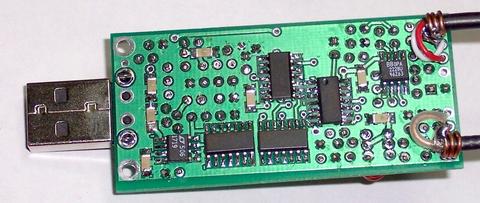|
SOFTROCK – an entry level project to SDR.
Software Defined Radio (called SDR from now on) is described as the implementation of the functionality of radio by using digital techniques and software. SDR is for Amateur Radio the equivalent of the Digital Camera for Photography. Ignore it if you wish, but you will be putting yourself at a severe disadvantage against others in future, as the technology allows you to obtain results which are impossible with conventional equipment.
SDR has probably been around for some five years, but the idea of replacing your expensive transceiver by an equally expensive blackbox and a powerful computer, just did not catch on with the Hamradio community.
However, the technology is certainly very intriguing, and a few dedicated Hams wanted to experiment and understand more about the capabilities of SDR. One such, Tony Parks (KB8YIG), together with Bill Tracey (KD5TFD) built an absolute minimal direct conversion receiver using standard components (costing about $10), connected it to a PC and found that they had created a 40 meter full-band receiver with sensitivity and selectivity better than a regular transceiver! They enrolled help from other amateurs with software experience to develop/adapt personal computer programs to use with this unit, and named it the Softrock project. “Soft” because the whole receiver depends on the PC software and “rock”, because the local oscillator is crystal driven. To encourage other amateurs to play with SDR, Tony offers an entry level Softrock kit consisting of his printed circuit SMD board (matchbox sized) and all the components, for sale at $11 (shipping included).

The SoftRock-40
Today, 18 months on, several models have been developed for the different bands 160, 80, 40, 30, 20 meters. There is even one for 10.7 MHz, so that Softrock can be used to process the IF picked out from a normal transceiver. Tony’s sales must now be counted in the thousands of units. That in itself is amazing, but all those amateurs who have bought these kits are full of ideas and are fuelling the evolution to ever more complex and exciting modifications.
There are now 6 different software packages available, all of them are FREE.
Windows and Linux OS are supported.
The Softrock community provides user assistance through Yahoo!groups
Softrock hardware receivers are a stable build now (at version 6.1)
Tony and a group of European Hams, built a transmitter using the same techniques, and piggy-backed it on the v.6.2 Softrock receiver. They then brought it on to one single board, the RXTX v.6.1 which is a 1 watt SSB transceiver (cigarette package size). Transceiver software programs are available. The unit can be used for CW, and as from a few weeks ago, you can run various digital modes by linking in existing software packages. (N.B. You can work the world on PSK with 1 watt. The first PSK Softrock to Softrock QSO was between Italy and the UK very recently.)
Now, from Feb 2007, you can buy RXTX 6.1 kits from Tony either for 160 meters or 80/40 meters or else 40/30 meters. They cost a bit more than the receiver alone ..$32 (shipping included).
Other ideas abound…Class-E SSB Amplifiers to boost the transmitter output power, for example.
For those really bitten by the bug, there is another kit project called HPSDR (High Performance Software Defined Radio), where they are developing specific hardware in modular/rack form and optimizing the special analog/digital interfaces with custom designed computer boards, in order to gain another order of magnitude performance jump. This will put these Hams way ahead of today’s commercial transceivers.
Remembering that everything is done in a digital computer, it is now possible to keep digital copies of all the received signals across the entire radio band. You can play them back, and with different selection settings (mouse click / keyboard), extract the other stations you missed while listening originally. So, you can record an entire weekend of contest activity (on hard disk or CD) and play it back later to see what stations you missed! Or, who was the station with sidebands causing you QRM while you were trying to work an elusive DX station? Or, maybe you want to send a digital copy of what you actually received to stations you had a QSO with…. was it really a 59 signal?
I can think of at least another half-dozen innovative possibilities to examine.
It’s all happening now, so, what’s holding us (or at least me) back?
Well……. For those of us with weak eyesight and shaky hands, the assembly of even the simplest SMD kit is a challenge. I am told it is not that difficult, but maybe MARL can help by asking those experienced in SMD to set up a bench at the club and show us how.
I think we all have access to a personal computer (either your own or in the family). MARL has a couple! But what do you need to run Softrock? According to what I have been told, you should have a PC with at least 500 MHz clock for the simplest receiver software (called Rocky). For good performance, and especially for the transceiver software (like KGKSDR), 1000 MHz is a minimum, but 2300 MHz would be more comfortable.
For a simple receiver, the interface to Softrock is a regular sound card (usually in most modern PCs), but for better performance (S/N and bandwidth) there are special sound cards (internal or external to the computer) which can be used. This might cost you up to Lm. 50, if you really have to buy one.
So, anyone else want to play? To quote one radio amateur… I have not had so much fun with Amateur Radio in the last 30 years as I have had since I got my first Softrock kit.
Robin, 9H1ZZ |
|
